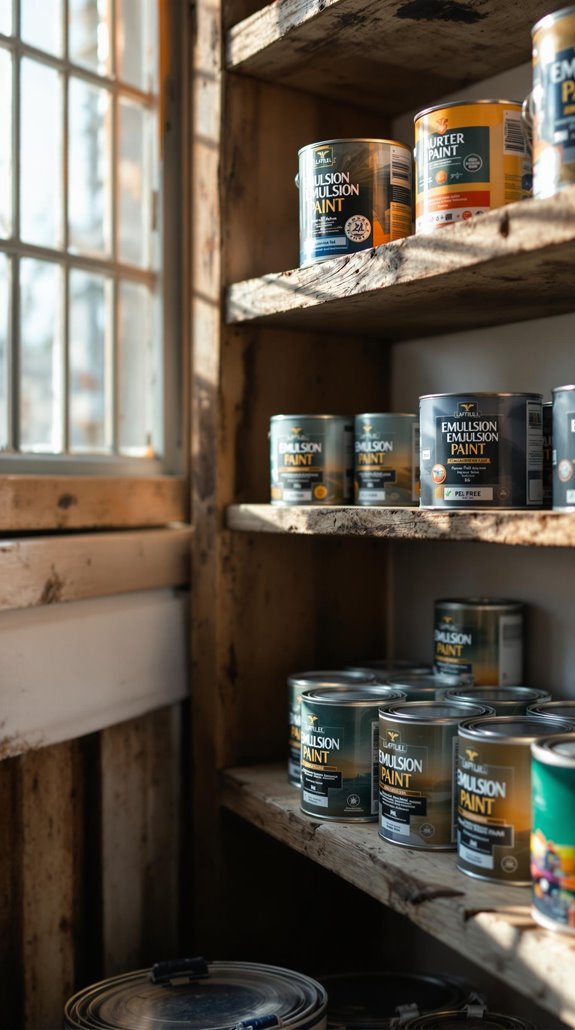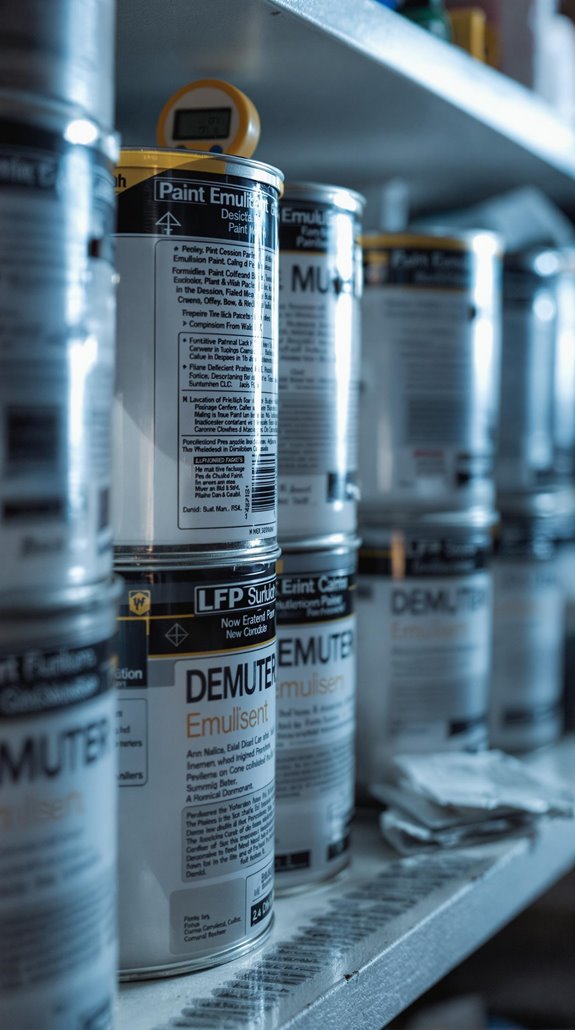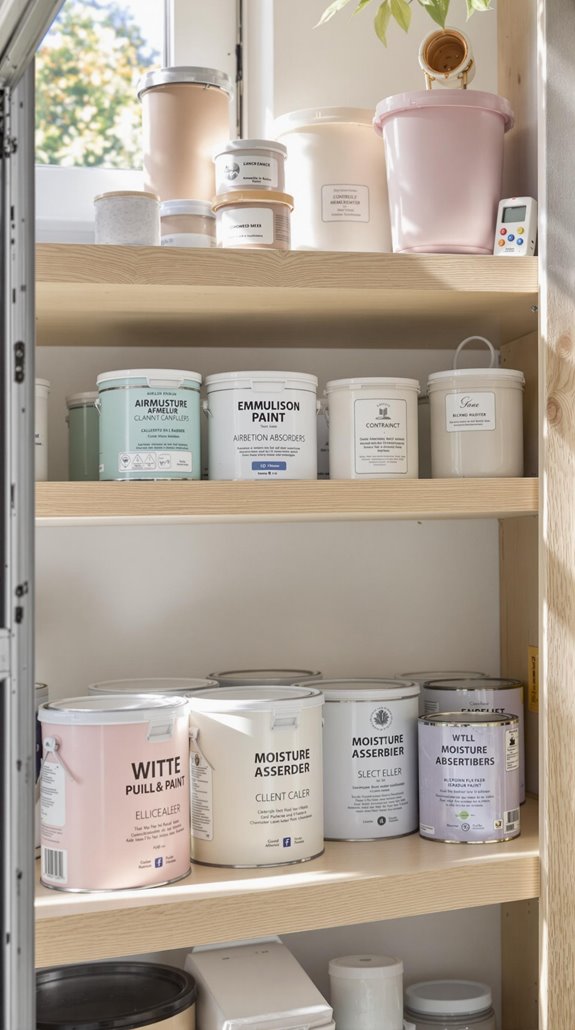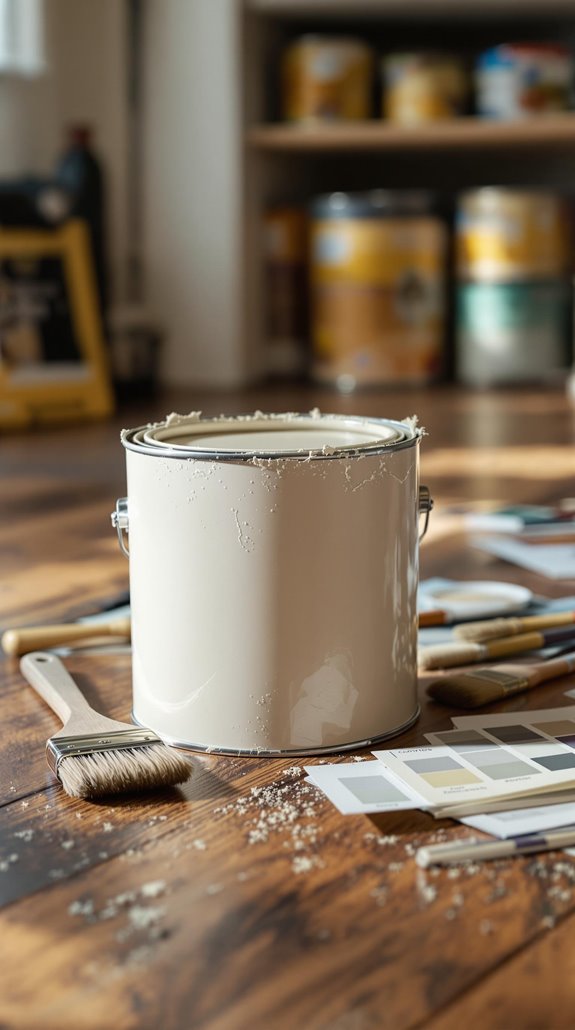I’ve learned that nothing’s more frustrating than opening a can of emulsion paint only to find it’s turned into a chunky, unusable mess. Whether you’re a weekend DIYer or tackling larger projects, understanding how long your paint will last can save you serious money and prevent those disappointing moments when you’re ready to work. The shelf life depends on several factors I’ll share, plus some storage tricks that’ll extend your paint’s usability far beyond what you’d expect.
Key Takeaways
- Unopened emulsion paint lasts 5-10 years when stored properly, with premium brands lasting up to 15 years.
- Opened emulsion paint remains usable for 1-5 years if stored in cool, dry conditions between 59°F-77°F.
- Transfer leftover paint to smaller containers and seal tightly to reduce air exposure and extend lifespan.
- Donate usable paint to community theaters or Habitat ReStores instead of disposing to save money.
- Bad paint shows chunky texture, sour smell, or mold growth – dispose safely following local regulations.
Unopened Emulsion Paint Shelf Life Expectations

The shelf life of unopened emulsion paint depends heavily on storage conditions and paint quality, but you can expect most cans to remain usable for 5-10 years when stored properly. I’ve found that premium brands often outperform budget options, sometimes lasting up to 15 years when undisturbed and well-sealed. Most manufacturers print “best before” dates on their cans, typically spanning 5-10 years from production.
You’ll get the most value by checking those batch codes to track production dates. Budget brands usually degrade after 5-7 years, while high-quality formulations maintain their integrity longer. Don’t overlook technical datasheets—they’re goldmines for maximum shelf life information. Remember, UV-resistant or low-VOC formulations might have shorter lifespans due to their specialized additives. Store your paint in a cool, dry place rather than areas with temperature fluctuations to maximize longevity.
How Long Opened Emulsion Paint Remains Usable
Once you’ve cracked open that emulsion paint can, you’re working with a significantly shorter timeline—expect 1 to 5 years of usability depending on how well you store it. I’ll help you maximize that lifespan and protect your investment.
Store your opened paint in a cool, dry location between 59°F and 77°F, away from direct sunlight and heat sources. Clean the can’s rim before sealing, then use a rubber mallet to tap the lid securely around the edges. For extra protection, place plastic wrap over the opening before closing.
Avoid contamination by keeping dirty brushes out of the paint and minimizing how often you open the container. If your paint separates over time, don’t panic—thorough stirring can often restore its consistency and performance. A sour smell is the most reliable indicator that your emulsion paint has gone off and should be replaced.
Warning Signs Your Emulsion Paint Has Gone Bad
Before you grab that brush and start your next project, I’ll show you the clear warning signs that indicate your emulsion paint has deteriorated beyond use.
First, check the texture after stirring. If you notice chunky, cottage cheese-like consistency with persistent lumps that won’t blend, your paint’s gone bad. A thick, unremovable skin signals serious deterioration.
Next, trust your nose. Sour, rancid, or moldy odors mean microbial contamination has occurred. Fresh paint shouldn’t smell offensive.
Look for visible contaminants like green, black, or white mold spots, rust particles, or discoloration patches. These indicate your paint’s compromised.
Finally, examine your container. Rust, damaged seals, or bulging cans compromise paint integrity. When applied, bad paint creates streaky coverage, poor adhesion, and gritty residue. Additionally, watch for adhesion issues when the paint fails to stick properly to surfaces, making it completely ineffective for your project.
Environmental Factors That Affect Paint Longevity
While you can’t control Mother Nature, understanding how environmental factors assault your paint will help you make smarter choices and budget for maintenance. UV exposure wreaks havoc on south-facing walls, causing fading and chalking that’ll force you to repaint 2-3 years sooner than shaded areas. High humidity traps moisture beneath your coating, creating blistering and peeling within 1-2 years if surfaces aren’t properly sealed. Temperature swings above 15°C stress paint films daily, while freezing makes them brittle and prone to flaking. Chemical pollution from acid rain and airborne contaminants accelerates deterioration, especially near industrial areas. Even your microclimate matters—wind-driven debris wears paint down, while vegetation increases moisture retention and biological growth. Premium paints with UV blockers and weather-resistant compounds significantly outperform lower-grade options in harsh conditions.
Proper Storage Techniques to Maximize Paint Life

External conditions will pummel your paint job, but what you do with leftover paint determines whether you’ll have matching touch-up material when you need it. I’ll share the storage tricks that keep your emulsion paint fresh for years.
First, transfer paint to containers that match your leftover volume—less air means longer life. Glass jars work brilliantly for small amounts. Clean those rim edges spotless before sealing, then place plastic wrap between the lid and opening for an airtight barrier.
Store containers in cool, dry spots like interior closets, maintaining 60-80°F temperatures. Skip the garage—temperature swings kill paint fast. Most paint products have a shelf life of two years once opened, so proper storage becomes crucial for maximizing your investment. Here’s a pro tip: store cans on their sides to prevent skin formation. Label everything with project names and dates. You’ll thank yourself later when touch-ups are needed.
Temperature and Humidity Requirements for Paint Storage
Temperature and humidity control make the difference between paint that’s ready for touch-ups and expensive waste you’ll dump down the drain. I’ve learned the hard way that emulsion paint needs consistent storage between 10-30°C (50-86°F). When temperatures drop below freezing, your paint will gel, separate, and clump into unusable mess. Heat above 43°C (110°F) creates skin formation and settling that ruins the consistency.
The real killer? Temperature fluctuations. Those freeze-thaw cycles in unheated garages destroy paint faster than anything else. I store mine in climate-controlled spaces like basements or utility rooms where temperatures stay steady. Keep containers off the ground to protect from moisture and freezing that can compromise paint quality. Skip the shed or garage unless you’ve got heating. Your wallet will thank you when that leftover paint flows smoothly two years later.
Cost-Saving Strategies for Paint Purchase and Storage

Since paint costs can drain your renovation budget faster than a leaky bucket, I’ll share the purchasing and storage tactics that’ve saved me thousands over the years.
I buy paint in 5-gallon buckets for large projects, cutting costs by 40% versus gallon cans. Stock colors like beige or gray slash expenses by half compared to custom shades. I hunt seasonal sales at big-box stores where discounts reach 40%. High-quality materials can also make a difference in the longevity of your paint job.
For storage, I keep unopened paint in cool, dry spots away from heat—extending shelf life up to 10 years. I seal lids tightly and place cans on their sides to prevent clumping. Clean tools prevent contamination, and I never mix old paint with new. Flat or matte paints typically cost less than glossier finishes, making them excellent options for budget-conscious projects.
I also tap into paint-reuse programs and contractor suppliers for bulk discounts that stretch every dollar.
Comparing Emulsion Paint Lifespan to Other Paint Types
Smart paint purchasing means understanding how different paint types age, both in the can and on your walls. I’ve found that emulsion paint offers solid value – unopened cans last five years, and once opened, you’ll get at least a year with proper storage.
Oil-based paints win the longevity game, lasting up to 15 years unopened and 10 years after opening. However, they’re becoming less common due to environmental concerns.
Latex and acrylic paints match emulsion’s performance, typically lasting 2-10 years depending on storage conditions. Temperature extremes can significantly damage water-based paints like latex, with freezing causing streaks and excessive heat thickening the paint.
Limewash paint provides 5-10 years of coverage but requires more maintenance than modern options.
Chalk paint and milk paint fall short – chalk paint lasts just one year in the can, while mixed milk paint spoils within a week.
When to Dispose of Old Paint Safely

While old paint might seem harmless sitting in your garage, knowing when it’s time to dispose of it safely protects both your health and the environment. I’ll help you identify the warning signs that mean it’s disposal time.
If your emulsion paint smells foul, that’s bacterial growth telling you it’s gone bad. Lumpy texture or separation that won’t mix? Time to let it go. Don’t pour liquid paint down drains—it’s toxic to waterways.
For latex emulsion, I recommend mixing with cat litter or sawdust to dry it completely before trash disposal. Spread thin layers on cardboard for faster drying. Consider donating usable paint to community theaters or Habitat ReStores. Always check your local regulations first—some areas require special disposal methods.
Industrial paint requires different disposal methods than residential paint due to its hazardous classification under federal regulations.
Money-Saving Tips for Leftover Paint Management
Managing leftover paint properly can save you hundreds of dollars on future projects while reducing waste. I’ll share my proven strategies that keep paint fresh and your wallet happy.
First, I transfer paint to smaller glass containers and seal them airtight with plastic wrap under the lid. This prevents that costly skin formation. I store containers upside down between 60-80°F in dark spaces. Proper storage conditions can significantly extend the life of your paint.
For organization, I label everything with color, room, and opening date. My digital inventory with photos helps me track what’s available before buying new paint.
I’ve found creative reuses work brilliantly – combining compatible leftovers for base coats, using small amounts for furniture touch-ups, and creating custom sample boards. When I can’t use everything, I donate to local theaters or participate in paint swap programs. Remember that water-based paints are much easier to handle and dispose of compared to oil-based alternatives when your stored paint finally reaches the end of its usable life.
Conclusion
I’ve shown you how proper storage can stretch your emulsion paint’s life from months to years. By sealing cans tightly, storing them in cool spaces, and transferring leftovers to smaller containers, you’ll cut waste and save money. Don’t forget to check for warning signs like odd smells or chunky textures before using old paint. These simple storage techniques will keep your paint budget under control and your projects looking professional.
References
- https://www.homebuilding.co.uk/advice/does-emulsion-paint-go-off
- https://propertyworkshop.com/paints/does-emulsion-paint-go-off/
- https://www.thespruce.com/paint-lifespan-4587472
- https://legislature.maine.gov/testimony/resources/ENR20230215Capron133209153341470113.pdf
- https://www.youtube.com/watch?v=0p_3700VHDQ
- https://www.bhg.com/how-long-does-paint-last-7975332
- https://ondemandpainters.com/how-long-does-paint-last-life-tips/
- https://www.ultimatehandyman.co.uk/forum1/viewtopic.php?t=106471
- https://www.improovy.com/blog/how-long-does-paint-last
- https://www.fivestarpainting.com/blog/2022/march/how-long-can-you-keep-paint-before-it-goes-bad-/

